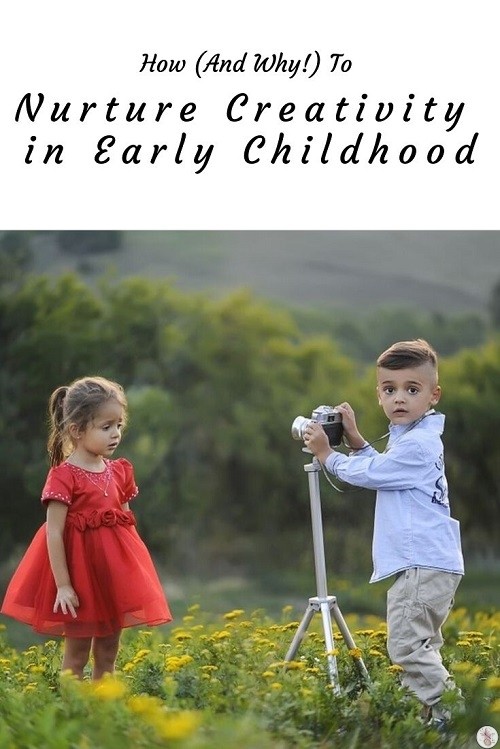The benefits of art, music, and literature in education cannot be overstated. Early exposure to creative arts is imperative in the healthy emotional and intellectual development of all children. In 2019, this may seem obvious to most parents, who have been exposed at some point in their younger years to arts or music education.
But the liberal arts are under attack: in elementary schools across the country, more than 1.3 million students miss out on music education of any kind, and nearly double that do not receive any visual arts education. Now more than ever, parents should be diligent in nurturing the creative instincts of our children. Here are 3 ways you can promote creativity in your young child at home.

Music
Music has a profound effect on the development of reading skills and vocabulary in young children. Even when music classes provide low-quality instruments for their students’ instruction, students that have the opportunity to use these lower quality instruments still score higher on standardized tests and have higher, more consistent attendance rates than students in schools without any music education. If you want your child to learn to play an instrument, navigate to this website.
Students do better in other subjects across the board, including English and maths, when they participate regularly in music classes. Overall, regardless of the socioeconomic status of a community, students with music education fare better in all of their classes when compared to students who do not take any music classes. Therefore, you can check out violin lessons for your child to support his education. You can also look for the finest school, like Music Academy of Texas, where you can enroll your children and have them learn different kinds of instruments.
So what can you do at home to provide a musical outlet for your child—without breaking the bank or your eardrums with a new drumset? Start out with a cheap recorder set or a tambourine. Get one for yourself, too, and have fun playing and learning alongside your young child. In the process, you will make memories the both of you can cherish. There are also websites, such as Fiddlersguide, that offer advice on how to get started learning musical instruments. You may also invest in a high-quality speaker for when you and your kids are listening to music.
Be sure to share your tastes in music with your child, no matter the genre or style (providing the lyrics, when applicable, are age-appropriate). Share the music you liked when you were younger or your child’s age. They will likely be very pleased to share that fun part of your life with you without even realizing that they are being educated in the process! If they want to learn more about music, you may visit sites like https://www.savethemusic.org/ to look for music education resources that may be beneficial to your kids. You may also register them for Online Vocal Studio lessons if they show potential to be a singer.
Creative Writing
Creative writing, like music, promotes an advanced vocabulary and better reading comprehension. Did you also know that it inspires confidence in children and helps refine their tools of self-expression? It’s true! Creative writing spurs the imagination and encourages children to take chances with art and expression. An active and well-developed imagination gives rise to excellent problem-solving skills.
Creative writing gives children the opportunity to explore feelings and observations of the world without feeling self-conscious. And, as they say, practice makes perfect! Over time, creative writing will refine your child’s ability to share their thoughts with the world in meaningful and thoughtful ways.
Encourage your child to keep a journal, but assure them that this is NOT a means for you to violate their privacy. It is important to respect expectations of privacy your child has (and deserves). Buy your child a journal or, better yet, let them pick it out themselves, and then let them go at it however they please. Whether its writing fiction or about their daily life, remind them that their journal is their safe place, and that you will never violate it (and, of course, stick to this promise!).
With older children who are voracious writers and readers, consider Amazon self-publishing. Many authors, like the CaribYogi, self publish on the internet as a means of sharing their work without the hassle or roadblocks of traditional publishing.
Visual Arts
The making of art helps children develop their fine motor skills. Especially for young children, creating art is instrumental in refining their dexterity. Dissecting of art also enhances a child’s vocabulary, teaching them shapes, colors, and concepts that only art can truly embody. Further, the choices a child makes in the creation of art promotes decision making and confidence.
Another added bonus to arts education is the exposure to different cultures through art: the same can be said of music, but visual art especially can give children touchstones into different cultures and histories they would never otherwise have been exposed to.
Other than the obvious routes, such as just giving your children the tools they need to make art on their own time, you can encourage artistic creativity in your kids by incorporating visual art into the everyday. For example, buy icing and let your kids decorate the brownies you make on the weekends. Or, if you’re throwing a party, let your children help make the decorations. Give them the tools and tell them to think outside the box. When you’re decorating the home or for an event, show your kids how it’s done and get creative! Take chances! Always find ways to turn the mundane into the extraordinary, and your children will follow your lead.
